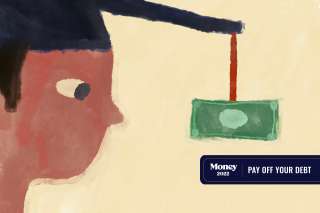3 Tips to Lower Your Student Loan Debt This Year

This article is part of Money's January 2022 digital cover, which features 22 ways to make 2022 the best money year of your life. Browse all 22 articles here.
Paying down debt — student loans or otherwise — is a perennial item on New Year’s resolution lists. But like many a resolution, it’s easy to lose your motivation as the year goes on, especially if you don’t have a clear plan of attack.
These moves, which get a boost from the current freeze on federal loans through May 1, will help you make that plan.
Here’s how to pay down student loan debt faster this year.
Take advantage of the final days of your 0% interest rate
Federal student loan payments were set to resume in February, following a nearly two-year-long freeze. But borrowers got some welcome news before the holidays: the payment pause and interest waiver will last three months longer. This means that any amount you pay before May will go further in decreasing your debt than it would later in the year, when it will get eaten up by interest.
“A 0% interest opportunity rarely comes along,” says Dan Rooker, a financial planner and certified student loan professional.
How much you can knock off your total debt depends, of course, on how much you owe and what your interest rate will be after the pandemic-era relief ends in May. (All loans will revert back to the same interest rate you had before the pandemic.)
But, for the sake of an example, let’s say you owe $40,000 with a 6% interest rate, and you’re on track to pay that off in 5 years. If you make a one-time $4,000 payment and then return to making the same monthly payments of $773 after the forbearance period ends, you’ll pay off your debt 6 months faster. Perhaps more motivating? You’ll save $1,300 in interest.
“You’ll be swimming against the current again starting in May,” Rooker notes.
Make multiple payments a month
You know the saying about more being merrier? Channel it when it comes to the frequency of student loan payments — the more you make, the easier it will be to shrink your balance (and, you know, the merrier you’ll be when you finally hit that long-awaited payoff date).
Paying even an extra $50 a month on our hypothetical $40,000 debt will help you pay it off four months earlier. The easiest way to do this is to plan your payments to coincide with the days you get paid, so you can direct money to your debt before you’re tempted to spend it elsewhere. Rooker recommends automating this through your checking account or payroll provider.
“You just have to make the decision once and then let technology work for you," he says.
Quick tip: Be sure to tell your loan servicer you want your extra payments to go toward the principal balance, not to count as a prepayment for the next month.
Refinance your loans for a lower interest rate
The allure of refinancing is simple: if you can snag a new loan with a lower interest rate while maintaining, or even increasing, your monthly payments, you’ll pay less overall.
The savings can be quite large, too. Data from Credible, a marketplace for student lenders, suggests that borrowers who accept a refinance offer in 2022 will save, over time, an average of $16,900 between the combination of a lower interest rate and shorter repayment period.
To be clear, refinancing is not a smart move for everyone. If you don’t have a strong credit score, reliable income and hefty emergency savings to tide you over should you lose your job, this isn’t the strategy for you.
But if you understand the risks — you’ll give up access to federal benefits and protections — and you’re otherwise a good candidate, now is a great time to refinance. Interest rates as of late December were still near historic lows, with average fixed rates for 5-year and 10-year terms in the 2% to 3% range.
Once you've weighed the pros and cons, follow these steps on how to refinance your student loans to ensure you get the best terms you can.
As you make one (or more) of these moves, remember that paying off your student debt is typically a long-term financial task. To keep your momentum going, plan to mark off smaller milestones along the way. Rooker and his wife, for example, printed out and colored in a “debt-thermometer” as they made progress paying down their own student loans. Each milestone came with a small reward of some sort.
“Celebrate along the way so you’re not just 'head down' working toward a future goal,” Rooker says.
More from Money:
Watch Out: These High-Risk Investments Will Be All the Rage in 2022